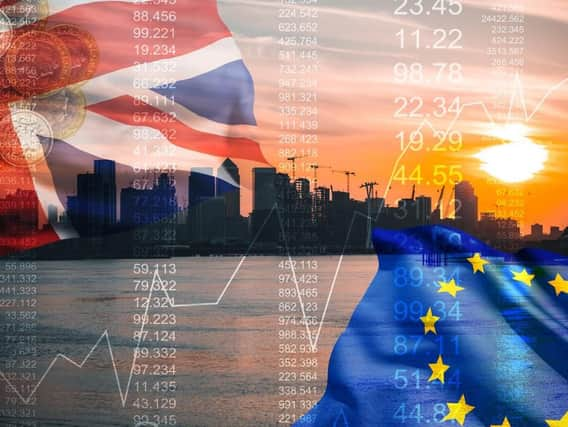Brexit fears for sterling sparks sharp warning to traders


Michael Boutros, currency strategist for DailyFX.com, one of the world's leading sources for news and analysis on the currency, commodity and index trading community, says a more difficult trading environment could lie ahead, and has warned short-to-medium term traders to “tread lightly”.
He’s also highlighted how the flood of news headlines and speculation surrounding Brexit talks means forex traders should “exercise stricter risk management in any GBP-based setups”.
His warning comes after a long period of difficulty for forex traders who have found the Brexit chaos has made it tricky to predict market moves on sterling and to determine its price.
The forex markets were plunged into crisis in the wake of the Leave vote, when the pound’s value against the US Dollar plummeted. The fragility of the pound against the dollar and the euro has continued as the 'deal or no deal' drama has escalated within the House of Commons.
The scale of the issue is clear by comparing events at the height of the 2008 financial crash, when the pound’s biggest intraday trading range was only 6.5%. That compares to the 13% intraday trading range of the pound the day after the Brexit vote.
According to DailyFX experts, the only hope for significant recovery for the British Pound is if Brexit is completely avoided – something that would appear significantly less likely with the arrival of hardline ‘Leave’ advocate Boris Johnson as Prime Minister.
The analysts warn that a no-deal, hard Brexit is likely to result in further losses by the British Pound, as the European Central Bank and Federal Reserve act to cut interest rates to prevent Brexit fallout hitting Eurozone or US economies.
They suggest EUR/GBP is likely to trade closer to parity (£1.0000) while GBP/USD could fall towards $1.1000 in the first year.
Brexit hits forex traders
However, it’s not all gloom – as recent research on professional forex trading has shown, the unprecedented scenarios raised by Brexit have some thriving in the volatility and seeking fresh trading opportunities. Others, however, are finding it difficult to gamble in the markets.
Recent events have seen day trading the forex markets become increasingly popular thanks to 24 hours a day, five days a week trading, an average volume of more than $3.2 trillion traded per day and a plethora of trading angles to take – from dealing with the eight leading currencies to plenty of regional currency pairings to trade too.
However, the spectre of Brexit has meant the technical indicators which play a key role in influencing trade decisions regarding sterling – such as historic price trends and patterns which can influence future movements – have been overshadowed by ‘fundamental indicators’ based on news, events, releases and economic data.
Michael Boutros said: “Market support and resistance for the pound has largely been based on the negotiations between the UK government and the EU. It’s been a case of reading between the lines with various news conferences and press releases.
“Traders must be mindful of the barrage of headlines coming from officials and should exercise stricter risk management in any GBP-based setups.
“The Brexit talks have the potential to spark unforeseen and sudden surges in volatility and make for a more difficult trading environment for short-to-medium term traders.”
Sterling: what next?
Nicholas Cawley, an analyst for DailyFX, says: “A no-deal Brexit will see sterling spinning lower, with GBPUSD expected to quickly re-test the October 2016 low around 1.1800 before heading lower.”
However, he remains optimistic, adding: “While sterling will lose some of its attraction, it will remain a major currency and further sell-offs will attract international buyers looking at buying a currency at multi-year lows, stemming losses.
“Any Brexit deal that allows for seamless trade from November 1 will be met with a substantial rally, as investors re-position themselves after over three years of uncertainty. GBPUSD should re-test the March 2019 high around 1.3380 before pushing back above 1.3500 and on towards 1.4000.”
He points out that the financial implications of Brexit aren't solely tied to the UK's ability to negotiate a deal: a no-deal Brexit could trigger a second Scottish independence referendum, while opposition to Brexit may well have hardened in light of recent events.
“A no-deal Brexit and Scotland voting to leave the UK would weigh very heavily on sterling in the short-term and push prices sharply lower,” says Cawley.
DailyFX’s experts have suggested that a no-deal, hard Brexit with a Scottish vote to leave the UK could see EUR/GBP climb towards £1.0500 and GBP/USD to drop closer to $1.0500.
Mr Cawley added: “The fracturing of the United Kingdom would hit sterling hard and in combination with a no-deal Brexit may well push investors to the side-lines when looking at sterling assets.”
DailyFX.com is a free news and research website from IG, one of the world's leading sources for news and analysis on the currency, commodity and index trading community. Its analysts report daily on the latest changes in the ?nancial markets, providing timely fundamental, economic and technical analysis and a close examination of promising chart formations with live currency quotes.